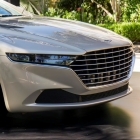Lagonda Taraf
- 11/11/2014Based on the Rapide and using the almost infinitely flexible VH architecture, the new saloon drew significant inspiration from the highly sought-after William Towns-designed Lagonda of 1976 and features many of the same cutting edge engineering techniques seen in modern Aston Martin sports cars like the Vanquish such as the use of carbon fibre body panels.
AML initially stated that the exclusive luxury four-door was being produced solely for the Middle East markets, but following serious enquiries from a number of wealthy customers elsewhere in the world AML announced days ahead of the 2015 Geneva Show, that the UK, European and South African markets would also be able to order the car. At the show during March, an example of the Taraf was exhibited within the VIP area. There was also some evidence that AML might have planned to market the Taraf in North America but it now appears not to have happened.
The Taraf was hand-built at Aston Martin’s manufacturing facilities in Gaydon, Warwickshire, in a dedicated building previously given over to the creation of the One-77 hypercar. Although no price was initially officially quoted, it is believed that British customers were be charged £580,000 plus VAT and German customers needed to find a sum towards a million Euros. Bespoke features commissioned from ‘Q’ will of course have pushed the price considerably higher.
Sales were anticipated to be quite low due in part to the extremely high sticker price and AML stated that an absolute maximum of only 200 are to be built in both left and right hand drive. In fact rather less examples were built making the Taraf one of the lowest volume VH cars ever made.
UK debut for the car was in the showroom of Aston Martin Works in Newport Pagnell in May 2015. The event coincided with the annual Bonhams auction and as the AMOC concours is traditionally held the next day, the Taraf was shown at Woburn Abbey too.
In an unusual spin off, it is rumoured that the extended Taraf chassis may form the basis of a long wheelbase Rapide for launch around 2017 although this sadly never happened.




















